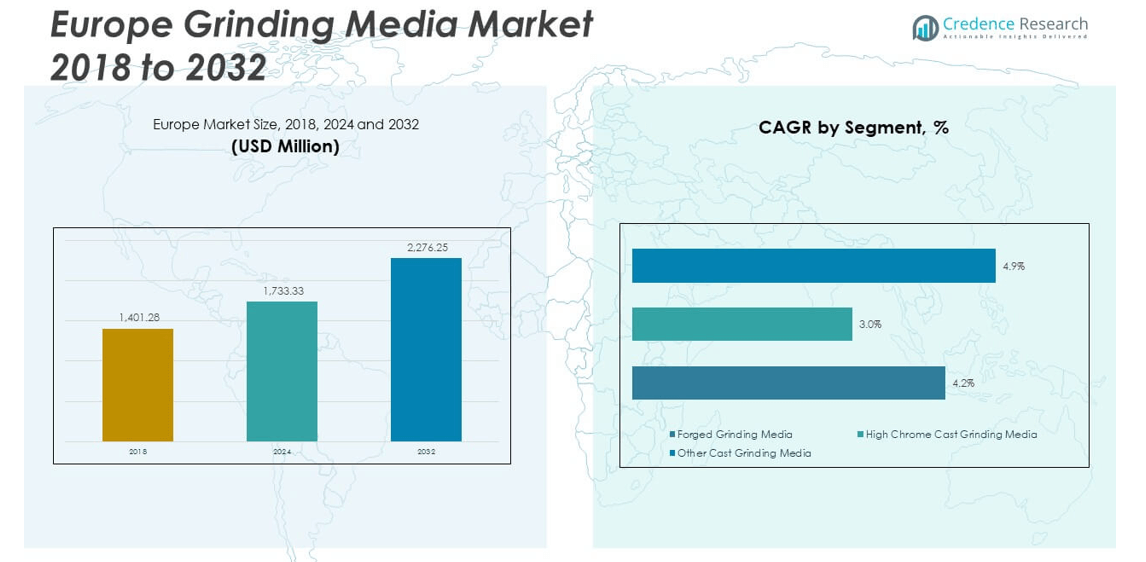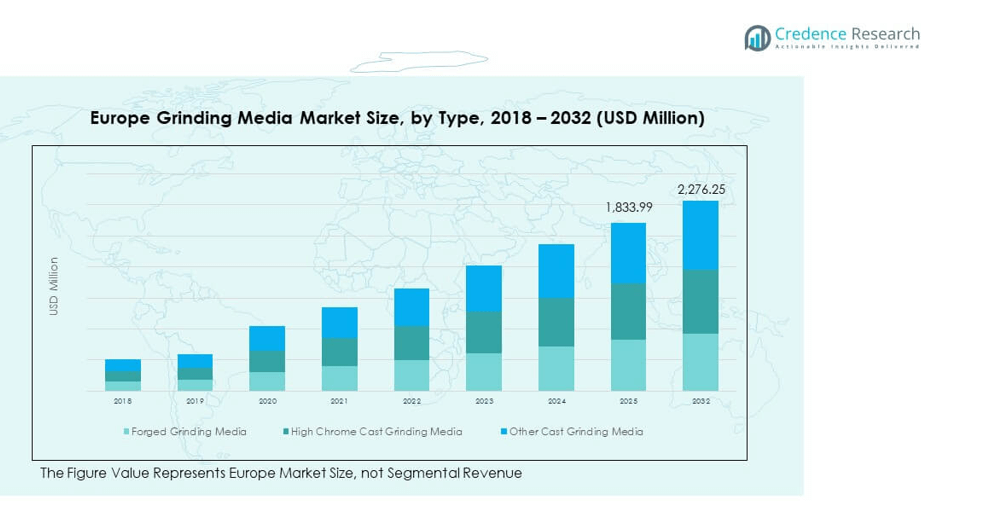CHAPTER NO. 1 : GENESIS OF THE MARKET
1.1 Market Prelude – Introduction & Scope
1.2 The Big Picture – Objectives & Vision
1.3 Strategic Edge – Unique Value Proposition
1.4 Stakeholder Compass – Key Beneficiaries
CHAPTER NO. 2 : EXECUTIVE LENS
2.1 Pulse of the Industry – Market Snapshot
2.2 Growth Arc – Revenue Projections (USD Million)
2.3. Premium Insights – Based on Primary Interviews
CHAPTER NO. 3 : GRINDING MEDIA MARKET FORCES & INDUSTRY PULSE
3.1 Foundations of Change – Market Overview
3.2 Catalysts of Expansion – Key Market Drivers
3.2.1 Momentum Boosters – Growth Triggers
3.2.2 Innovation Fuel – Disruptive Technologies
3.3 Headwinds & Crosswinds – Market Restraints
3.3.1 Regulatory Tides – Compliance Challenges
3.3.2 Economic Frictions – Inflationary Pressures
3.4 Untapped Horizons – Growth Potential & Opportunities
3.5 Strategic Navigation – Industry Frameworks
3.5.1 Market Equilibrium – Porter’s Five Forces
3.5.2 Ecosystem Dynamics – Value Chain Analysis
3.5.3 Macro Forces – PESTEL Breakdown
3.6 Price Trend Analysis
3.6.1 Regional Price Trend
3.6.2 Price Trend by Product
CHAPTER NO. 4 : KEY INVESTMENT EPICENTER
4.1 Regional Goldmines – High-Growth Geographies
4.2 Product Frontiers – Lucrative Product Categories
4.3 Application Sweet Spots – Emerging Demand Segments
CHAPTER NO. 5: REVENUE TRAJECTORY & WEALTH MAPPING
5.1 Momentum Metrics – Forecast & Growth Curves
5.2 Regional Revenue Footprint – Market Share Insights
5.3 Segmental Wealth Flow – Type & Application Revenue
CHAPTER NO. 6 : TRADE & COMMERCE ANALYSIS
6.1. Import Analysis by Region
6.1.1. Europe Grinding Media Market Import Volume By Region
6.2. Export Analysis by Region
6.2.1. Europe Grinding Media Market Export Volume By Region
CHAPTER NO. 7 : COMPETITION ANALYSIS
7.1. Company Market Share Analysis
7.1.1. Europe Grinding Media Market: Company Market Share
7.1. Europe Grinding Media Market Company Volume Market Share
7.2. Europe Grinding Media Market Company Revenue Market Share
7.3. Strategic Developments
7.3.1. Acquisitions & Mergers
7.3.2. New Product Launch
7.3.3. Regional Expansion
7.4. Competitive Dashboard
7.5. Company Assessment Metrics, 2024
CHAPTER NO. 8 : GRINDING MEDIA MARKET – BY TYPE SEGMENT ANALYSIS
8.1. Grinding Media Market Overview by Type Segment
8.1.1. Grinding Media Market Volume Share By Type
8.1.2. Grinding Media Market Revenue Share By Type
8.2. Forged Grinding Media
8.3. High Chrome Cast Grinding Media
8.4. Other Cast Grinding Media
CHAPTER NO. 9 : GRINDING MEDIA MARKET – BY APPLICATION SEGMENT ANALYSIS
9.1. Grinding Media Market Overview by Application Segment
9.1.1. Grinding Media Market Volume Share By Application
9.1.2. Grinding Media Market Revenue Share By Application
9.2. Power Plant
9.3. Cement
9.4. Mining and Metallurgy
9.5. Others
CHAPTER NO. 10 : GRINDING MEDIA MARKET – BY SALES CHANNEL SEGMENT ANALYSIS
10.1. Grinding Media Market Overview by Sales Channel Segment
10.1.1. Grinding Media Market Volume Share By Sales Channel
10.1.2. Grinding Media Market Revenue Share By Sales Channel
10.2. Direct Channel
10.3. Distribution Channel
CHAPTER NO. 11 : GRINDING MEDIA MARKET – REGIONAL ANALYSIS
11.1. Grinding Media Market Overview by Region Segment
11.1.1. Europe Grinding Media Market Volume Share By Region
11.1.2. Europe Grinding Media Market Revenue Share By Region
11.1.3. Regions
11.1.4. Europe Grinding Media Market Volume By Region
11.1.5. Europe Grinding Media Market Revenue By Region
11.1.6. Type
11.1.7. Europe Grinding Media Market Volume By Type
11.1.8. Europe Grinding Media Market Revenue By Type
11.1.9. Application
11.1.10. Europe Grinding Media Market Volume By Application
11.1.11. Europe Grinding Media Market Revenue By Application
11.1.12. Sales Channel
11.1.13. Europe Grinding Media Market Volume By Sales Channel
11.1.14. Europe Grinding Media Market Revenue By Sales Channel
CHAPTER NO. 12 : EUROPE GRINDING MEDIA MARKET – COUNTRY ANALYSIS
12.1. Europe Grinding Media Market Overview by Country Segment
12.1.1. Europe Grinding Media Market Volume Share By Region
12.1.2. Europe Grinding Media Market Revenue Share By Region
12.2. Europe
12.2.1. Europe Grinding Media Market Volume By Country
12.2.2. Europe Grinding Media Market Revenue By Country
12.2.3. Type
12.2.4. Europe Grinding Media Market Volume By Type
12.2.5. Europe Grinding Media Market Revenue By Type
12.2.6. Application
12.2.7. Europe Grinding Media Market Volume By Application
12.2.8. Europe Grinding Media Market Revenue By Application
12.2.9. Sales Channel
12.2.10. Europe Grinding Media Market Volume By Sales Channel
12.2.11. Europe Grinding Media Market Revenue By Sales Channel
12.3. UK
12.4. France
12.5. Germany
12.6. Italy
12.7. Spain
12.8. Russia
12.9. Rest of Europe
CHAPTER NO. 13 : COMPANY PROFILES
13.1. Magotteaux Group
13.1.1. Company Overview
13.1.2. Product Portfolio
13.1.3. Financial Overview
13.1.4. Recent Developments
13.1.5. Growth Strategy
13.1.6. SWOT Analysis
13.2. Energosteel
13.3. ABS Sfere
13.4. EL Stomana
13.5. Litzkuhn & Niederwipper GmbH
13.6. SUPRASTEEL
13.7. Fritsch GmbH
13.8. HOSOKAWA ALPINE Aktiengesellschaft
13.9. Maschinenfabrik Gustav Eirich GmbH & Co KG
13.10. Ziegler Mineralstoffe (Alubit grinding media)
13.11. Alpha Grinding Media
13.12. Metinvest
13.13. Others










